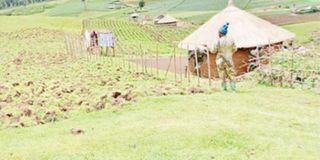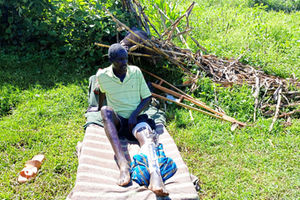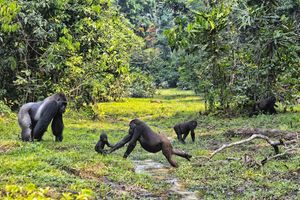
Some of the huts and gardens in Mt Elgon National Park in Kween District
Plant and animal species are now at risk of extinction in Mt Elgon National Park due to deforestation, posing a dire threat to ecosystems that people particularly in Bugisu Sub-region depend on for their survival.
The park, located on the border between Uganda and Kenya, covers an area of 494 square miles. It has more than 400 species of plants, birds and large mammals such as, elephants, buffaloes, and primates. The park is also an enormous watershed, supporting a rich diversity of altitudinal vegetation.
Statistics from the Uganda Wildlife Authority (UWA) indicate that deforestation has so far left a total of 1,935 acres (three square miles) of land cleared, as locals encroach on the parkland, especially, in Namisindwa, Bududa, Kween, Bukwo and Sironko districts. Daily Monitor learnt that on average, 10 people are arrested by UWA every month over illegal logging and other human related encroachments on the parkland.
The high rate of deforestation has led to disasters such as, floods, loss of soil fertility and drying rivers.
Ms Stella Namono, a resident of Bupoto Sub-county in Namisindwa District, says due to massive deforestation, Mt Elgon National Park is facing loss of tree species and soil fertility in the lower belts.
“The streams that flow from the mountain feed into rivers and make our soils fertile. However, this is now changing because the rivers are drying up. This means the source (the streams) has been tampered with,” she says.
“What makes matters worse is that the government seems not to be concerned. The high rates of deforestation are also endangering both the park’s fauna and flora. It used to be grassy, but now it is becoming bare,” she adds.
The Mt Elgon National Park forest is one of Uganda’s largest water catchment areas, feeding several lakes, rivers and swamps in eastern Uganda and western Kenya.
Daily Monitor investigations discovered that some tree species such as the Elgon teak, mahogany, neoboutonia, macrocalys, podocarpus latifolius and medicinal trees are facing extinction. Others include the fruit trees that are supposed to be food for the primates such as, white calabash monkey, red tail monkey and velvet monkey.
Mr James Manana, a resident of Masaba Sub-county in Sironko District, says locals in the districts that neighbour the park cut down the trees to clear the land for farming or settlement.
“This has been the major driver of wildlife decline and climate variations. Previously, we knew that the rains in the first season start in the month of February. However, this has changed. The rains now come in April. The degradation of the park is due to population pressure,” he says.
Besides cutting down trees, other disastrous activities taking place in the park include charcoal burning and poor agricultural practices, which are believed to be triggers of landslides that have claimed the lives of at least 1,500 people in Bugisu over the past ten years. Of the 1,500 deaths, 70 percent were registered in Bududa District.
Government role
The deforestation and encroachment needs to be tackled head-on because Mt Elgon National Park is a key biodiversity hotspot that is a critical source of water for millions.
Mr Samuel Amanya, the chief warden of Mt Elgon Conservation Area, says the encroachment is being fought.
“We are arresting loggers and charcoal burners, especially in Kween District, which is the lead encroacher. We are also encouraging people to voluntarily leave the park,” Mr Amanya says.
“The benefit of a well-managed and intact forest resource is significant biodiversity. Trees absorb carbon dioxide and turn it into wood, where the carbon stays bound up for hundreds or even thousands of years. Living forests are an important part of the earth’s climate system and growing trees soak up carbon dioxide from the atmosphere and store it in their trunks, roots, leaves, and forest soils,” he says.
Locals, however, accuse the government of double standards, saying it should first deal with factories that are releasing deadly pollutants into wetlands to show it is serious about saving the environment.
Mr Imran Muluga, the Resident District Commissioner (RDC) of Namisindwa, says the government has started community engagements on land restoration, desertification and drought resilience in the Mt Elgon Conservation Area.
“District leaders from the Mt Elgon Conservation Area had an engagement and were sensitised on ecosystem restoration with emphasis on tree planting. We resolved to champion tree growing and restoration and environmental education through radio talk shows and community sensitisation meetings,” he says.
Mr Ivan Magombe, a resident of Bushiyi Sub-county in Bududa District, says communities surrounding the park are engaging in restoration and conservation activities.
“We are now at the forefront of championing tree planting. Following a memorandum of understanding between UWA and the district surrounding the park, several hectares of indigenous trees have been restored through the Collaborative Forest Restoration Initiative,” he says.
Mr Bashir Hangi, the UWA communication manager, says they work with the existing government structures to support reforestation.
“We have areas in the park where we plant soft wood trees and invite the community to use the land for cultivation of crops as well. In this way, they cultivate with our knowledge and permission, and as they weed their crops, they also weed our trees, until such a time as the trees can no longer support their crops,” he says.
Mr Hangi adds that UWA is also fighting deforestation through collaborative resource management.
“We give community members specific days when they can enter the park to harvest resources for their daily use. Under our watchful eye, they organise themselves into groups, enter the park and harvest firewood or medicinal roots, barks, and leaves,” he says.
In April, the government unveiled plans to plant 300,000 high-value trees in eastern Uganda to mitigate the effects of climate change.
Boundary rows fuel deforestation
A report by the Ministry of Lands, Housing and Urban Development on boundary opening three years ago showed that both residents and UWA have encroached on each other’s land. For instance, in Sironko District, the community encroached on 836 hectares of the park’s land while UWA encroached on 89 hectares of the community land. In Bududa, the community encroached on 384 hectares while UWA encroached on 637 hectares.
Mr Hangi acknowledges that the boundaries have remained a thorny issue between UWA and the community.
“Even after the Ministry of Lands demarcated the park’s boundaries, the communities are disputing the demarcations, but we cannot do anything about it. UWA does not determine the boundaries of protected areas. Once the Ministry of Lands informs us where the gazette boundaries are, we guard them,” he says.
“Those who insist on entering the park illegally are cautioned, but repeat offenders are arrested and prosecuted according to the law. We are carrying out sensitisation campaigns and awareness education. However, some people are still stuck with the mentality that this has been their land since time immemorial,” he adds.









